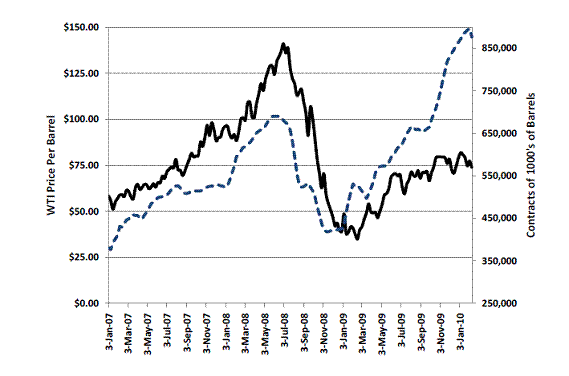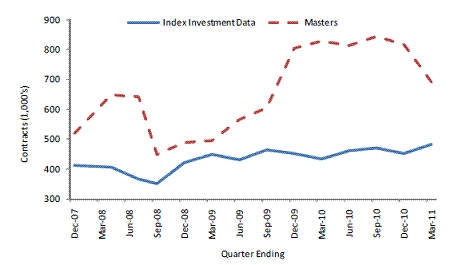There has been a lot of growth over the last decade in funds that take long positions in commodity futures contracts in order to offer investors an asset that follows raw commodity prices. I’ve been looking into some of the data that have been used to measure the size of those positions.
Hedge fund manager Michael Masters received a lot of attention in 2008 with his testimony before the U.S. Senate on the role that “financialization” of commodity futures markets may have played in the big increases in commodity prices being seen at the time. One of the ways he made his point was with a graph comparing the price of oil with an estimate of the number of oil futures contracts held by index funds who were buying these contracts on behalf of investors seeking direct exposure to commodity prices. Stanford Professor Ken Singleton has recently updated a graph illustrating the correlation, in which the black line is the price of crude oil and the dashed is an estimate of futures contracts held by index funds.
 |
How does one come up with an estimate of the number of futures contracts held by index funds? Masters relied on the Supplemental Commitments of Traders (SCOT) that the Commodity Futures Trading Commission began reporting in 2007. The CFTC used forms and interviews to identify traders in 12 agricultural commodities who were “replicating a commodity index by establishing long futures positions in the component markets and then rolling those positions forward from future to future using a fixed methodology”. Of these 12 commodities, one (soybean oil) is included in the Dow Jones-AIG commodity index but not in the Goldman Sachs Commodity Index. Masters’ assumption was that all of the index fund positions in soybean oil in the SCOT report were also holding crude oil futures in the proportions that somebody trying to replicate the DJ-AIG would have to hold. The SCOT also includes two agricultural commodities (KC wheat and feeder cattle) that are included in the Goldman Sachs Commodity Index (GSCI) but not in the DJ-AIG. Masters assumed that one or the other of these were held solely by funds seeking to replicate the GSCI, from which one gets an imputed volume of crude oil contracts held by those funds. Adding those two numbers of imputed oil futures holdings produces the dashed line in the figure above.
One immediate check on the validity of this procedure is whether the number of GSCI crude oil contracts implied by KC wheat estimates is similar to the number of GSCI crude oil contracts implied by feeder cattle. In the example used in the appendix to Masters (2008), which is based on January 17, 2006 numbers, the estimates are indeed similar. However, Irwin and Sanders (2011) note that for other dates the discrepancies are large. For example, Masters’ methodology would infer from the December 31, 2007 SCOT report that GSCI-based index funds were holding 286,000 crude oil contracts if the estimate was based on feeder cattle positions but 468,000 contracts if based on KC wheat positions. Also, as noted by Irwin and Sanders (2011) and Singleton (2011), a small deviation from assumptions results in a huge error in the inference. In particular, feeder cattle only have a weight of 0.47% in the GSCI, which means that number gets multiplied by 213 to produce an estimate of crude oil holdings. Any error in the assumptions is thus getting multiplied by several hundred before generating an inferred value for crude oil. An additional problem is that the reported positions of index traders include short positions, something a pure index fund would not do, and again inconsistent with the methodology.
Given the need for better data, since 2008 the CFTC has been conducting an on-going “special call” of all swap dealers and index funds known to be significant users of U.S. futures markets, which it summarizes in a separate Index Investment Data report. Irwin and Sanders (2011) describe the source of these data:
Each firm’s entire book related to commodity index investments is reported, not just the netted
amount that may be managed ultimately in the futures markets. The Index Investment Data (IID)
is cross-checked by comparing it to the positions reported through the CFTC’s larger trader
reporting system and by engaging the firms in extensive discussions.
Another huge advantage of the IID data is that it includes direct estimates of crude oil futures contracts, rather than trying to impute them from holdings such as soybean oil.
Irwin and Sanders used the Masters methodology to infer positions of crude oil positions of index fund traders as of the end of each quarter, which is summarized by the dashed line in the figure below. For comparison, the long positions in crude oil contracts of index-fund traders as reported in the IID data is shown in the solid line. This comparison suggests that the Masters methodology is likely off by huge amounts.
 |
Unfortunately, the IID data are not available at higher frequencies, so some researchers are still making use of Masters-type imputations. Singleton’s (2011) regressions suggest that the imputed series can help predict crude oil futures prices. Given the evidence above, this result seems puzzling.
Really interesting. Thanks.
The four-word refutation of the financialisation hypothesis is “coal and iron ore”.
No futures market to speak of. No index funds of any importance. Prices have risen, if anything, faster than oil.
Professor,
Question: Why are people so concerned with index funds? To my knowledge, all they are doing is to buy into the second or third contract on the futures curve. After a month or two (depending on commodity) the position is rolled over by selling the old contract and buying a new one further out the curve. Index funds are therefore not net buyers of commodities, and their presence in the market should only affect the shape of the futures curve, not the spot price.
Am I wrong? If so, why?
Asger Wingender: Theoretical discussions of how the rolling over of futures contracts might affect the spot price are provided by Singleton (2011) and Hamilton (2009). The claim that they have actually had significant effects of this type remains controversial.
Excellent point Commodity currency. Not only do coal and iron markets lack significant future markets, prices are determined through protracted negotiations.
Per the EIA, coal is at the same price as 1990, whereas LS-Cushing was at $20 not todays $81.
I am just a lawyer. I have been involved in commodities law for over 20 years. What is described in the article differs very little from commodity pools. The pools are usually formed when some trader comes up with some brilliant idea for being smarter than the market. I have never seen one succeed for very long. In the long run no one outsmarts the market. They just keep on trying. I assume that commodities contracts do effect spot market prices. It follows from the fact that most futures are sold to businesses which are hedging their own long term contracts (as is required by CFTC regulations). The costs of the hedging are often added into the costs of the contracts for sale of the underlying commodity. Therefore, the futures contracts effect the underlying commodities’ spot prices. Nonetheless, I have a hard time believing that the effect is actuall “significant.” I would be surprised to find out that the effect exceeds 2.5% Am I wrong?